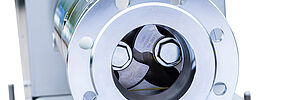Food pumps
As part of the production process, food often has to be conveyed from one station to the next. From a hygienic point of view, transport in closed systems is advantageous. Food pumps are therefore often used for liquid products, but also for pasty or even non-flowing products. An alternative would be conveyor belts, but these do not guarantee continuous transport in containers.
The term food pump is therefore not derived from the principle behind the pump, but from the application. There are many different designs. Centrifugal pumps can be used for liquid media, while positive displacement pumps are used for more viscous media. Twin-screw pumps can be used both as food pumps for the process and as feed pumps for the CIP run.
Regardless of the pressure and volume flow data, the important thing for all food pumps is that conveying does not have a negative impact on product quality. On the one hand, this requires a hygienic design that prevents the products from being contaminated by germs during passage. The design should be free of dead spaces and have a surface quality that ensures that cleaning is reliable.
As a rule, surface roughness of less than 0.8 µm is used as a benchmark for food pumps. EHEDG certification or 3A approval are good indicators of hygienic design. The most commonly used material is 1.4404 (316L). For aggressive media, higher-quality materials such as duplex or 1.4539 can also be used.
Another aspect to be considered with food pumps is the prevention of product contamination as a result of abrasion from the pump. Wear components such as the stators in PC pumps or scraper gates in sine pumps cause continuous input of impurities into the product, which means that depending on the application, the suitability of these pump types as food pumps should be looked at carefully. In the end, the important thing is to ensure that the mechanical action of the conveying process does not have a negative impact on the product properties.
Because their functional principles vary, there are considerable differences within the group of food pumps. Centrifugal and circumferantial piston pumps accelerate the product radially and cause considerable deflection, while other functional principles such as twin-screw pumps produce more even conveyance with low acceleration.
For food pumps, the range of applications in terms of quantity, pressure, viscosity and temperature is broad. For example, the task may be to convey frozen fruit juice concentrate at temperatures below freezing, or to convey liquid sugar masses at 150 °C. Some media are aqueous, while others such as butter or dough are so viscous that they have to be fed to the pump by extruders. When selecting a suitable food pump, all of these requirements and boundary parameters must be taken into account.
Among food pumps, the flexibility of the twin-screw pump stands out. Because its speed can be adjusted, the same pump can convey both liquid and highly viscous media. It can also cover a wide range of temperatures without design modifications.










